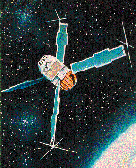|
|
Uhuru

Uhuru is the first satellite entirely devoted to the study
of the cosmic X-ray sources. This satellite was the first of a series of small
astronomy satellite sponsored by NASA.
Uhuru was launched on 12 December 1970 into an orbit of 560 km apogee,
520 km perigee, 3 degrees inclination, with a period of 96 minutes.
It had a spin period of ~12 minutes and
provided a comprehensive view of the entire sky with a sensitivity of about 0.001
times the intensity of the Crab nebula.
The main objectives of the mission were to survey the sky for cosmic X-ray sources
in the 2-20 keV range to a limiting sensitivity of
1.5 X 10-11 ergs/cm2/sec,
5 X 10-4 the flux from the Crab Nebula;
to determine discrete source locations with a precision of a few square minutes of
arc for strong sources and a few tenths of a square degree at the sensitivity
limit; to study the structure of extended sources or complex regions with a
resolution of about 30 arc minutes; to determine gross spectral features and
variability of X-ray sources; and, wherever possible, to perform coordinated
and/or simultaneous observations of X-ray objects with other observers.
The payload consisted of two sets of proportional counters each with ~0.084 sq-m
effective area. The counters were sensitive with more than 10 percent efficency
to X-ray photons in the ~ 2-20 keV range. The sensitivity lower limit was
determined by the attenuation of the beryllium windows of the counter plus a thin
thermal shroud that was needed to maintain temperature stability of the spacecraft.
The upper limit was determined by the transmission properties of the filling gas.
Pulse-shape discrimination and anticoincidence techniques were used to reduce the
background due to particles and high-energy photons. Pulse-height analysis
in eight channels was used to obtain information on the energy distribution of
the incident photons.
The two sets of counters were placed back to back and were collimated to
0.52° X 0.52° and 5.2° X 5.2° (full width at half maximum) respectively.
While the 0.5° detector gave a finer angular resolution, the 5° detector
had higher sensitivity for isolated sources.
[Uhuru Home]
[About Uhuru]
[Archive]
[Gallery]
[Publications]
Page authors: Lorella Angelini Jesse Allen
HEASARC Home |
Observatories |
Archive |
Calibration |
Software |
Tools |
Students/Teachers/Public
Last modified: Wednesday, 08-Oct-2003 19:04:09 EDT
|

